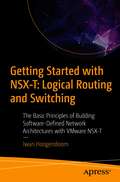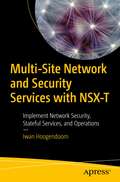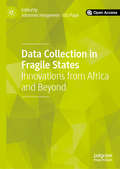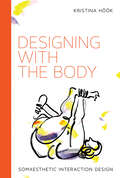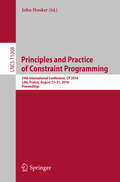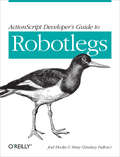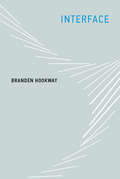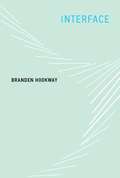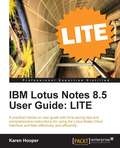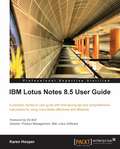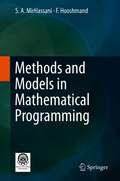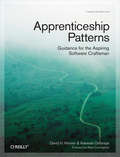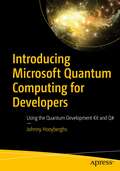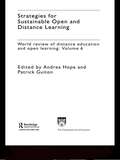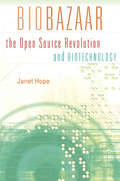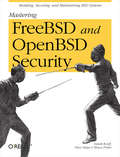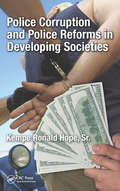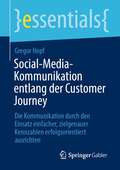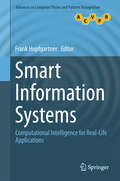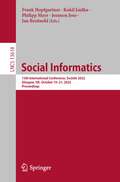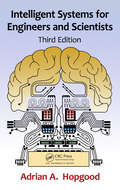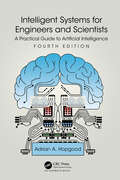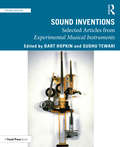- Table View
- List View
Getting Started with NSX-T: The Basic Principles of Building Software-Defined Network Architectures with VMware NSX-T
by Iwan HoogendoornThis primer on NSX-T helps you understand the capabilities and features of NSX-T, how to configure and manage NSX-T, and integrate NSX-T with other software. The book is the first in a series that will teach you the basics of NSX-T, which is an update of VMware's original software-defined networking (SDN) architecture aimed at making networks agile and flexible.You will become familiar with VMware's software-defined data center (SDDC) ecosystem and how NSX-T fits in. You will understand NSX-T components such as NSX-T Manager, NSX-T Edge Transport Nodes, and NSX-T Host Transport Nodes. And you will learn how to install and configure network services such as East/West and North/South routing capabilities, layer two switching, VRF, EVPN, multicast, and layer two bridging.The book provides best practices on how to configure routing and switching features, and teaches you how to get the required visibility of not only your NSX-T platform but also your NSX-T-enabled network infrastructure. The book explains security, advanced network features, and multi-site capabilities and demonstrates how network and security services can be offered across multiple on-premise locations with a single pane of glass for networking and security policy management. The interface with public cloud services is discussed and the book explains NSX-T operation in an on-premise private cloud and positioning and integrating NSX-T on a public cloud (off premises).What You Will Learn Understand how NSX-T fits in the VMware SDDC ecosystemKnow what NSX-T is, its components, and the terminology usedInstall NSX-TConfigure NSX-T network servicesManage the NSX-T networkWho This Book Is ForVirtualization administrators, system integrators, and network administrators
Multi-Site Network and Security Services with NSX-T: Implement Network Security, Stateful Services, and Operations
by Iwan HoogendoornKnow the basics of network security services and other stateful services such as NAT, gateway and distributed firewalls (L2-L7), virtual private networks (VPN), load balancing (LB), and IP address management. This book covers these network and security services and how NSX-T also offers integration and interoperability with various other products that are not only created by VMware, but are also referred by VMware as third-party integrated vendors.With the integration of VMware vRealize Automation, you can automate full application platforms consisting of multiple virtual machines with network and security services orchestrated and fully automated.From the operational perspective, this book provides best practices on how to configure logging, notification, and monitoring features and teaches you how to get the required visibility of not only your NSX-T platform but also your NSX-T-enabled network infrastructure.Another key part of this book is the explanation of multi-site capabilities and how network and security services can be offered across multiple on-premises locations with a single management pane. Interface with public cloud services also is included. The current position of NSX-T operation in on-premises private clouds and the position and integration with off-premises public clouds are covered as well.This book provides a good understanding of integrations with other software to bring the best out of NSX-T and offer even more features and capabilities.What You Will LearnUnderstand the NSX-T security firewall and advanced securityBecome familiar with NAT, DNS, DHCP, and load balancing featuresMonitor your NSX-T environmentBe aware of NSX-T authentication and authorization possibilitiesUnderstand integration with cloud automation platformsKnow what multi-cloud integrations are possible and how to integrate NSX-T with the public cloud Who This Book Is ForVirtualization administrators, system integrators
Data Collection in Fragile States: Innovations from Africa and Beyond
by Johannes Hoogeveen Utz Pape‘This open access book addresses an urgent issue on which little organized information exists. It reflects experience in Africa but is highly relevant to other fragile states as well.’ —Constantine Michalopoulos, John Hopkins University, USA and former Director of Economic Policy and Co-ordination at the World BankFragile countries face a triple data challenge. Up-to-date information is needed to deal with rapidly changing circumstances and to design adequate responses. Yet, fragile countries are among the most data deprived, while collecting new information in such circumstances is very challenging. This open access book presents innovations in data collection developed with decision makers in fragile countries in mind. Looking at innovations in Africa from mobile phone surveys monitoring the Ebola crisis, to tracking displaced people in Mali, this collection highlights the challenges in data collection researchers face and how they can be overcome.
Autocomplete: The Book
by Justin HookEvery time a browser autocompletes our search query, it's showing us what millions of other people all over the world are searching for. This curious collection showcases the very best of the often strange yet 100% real autocomplete suggestions offered up by popular search engines, compiling them into one hilarious, fascinating, and mildly disturbing volume. Each page contains one search and its 10 best autocomplete suggestions, including the most and least common, from "Why is Ryan Gosling...eating cereal?" to "If the Earth is round...why are shoes flat?" With easy-to-read spreads and playful black-and-white line art throughout, Autocomplete provides a nearly unfiltered look at what people actually search for when they think no one's watching.
Designing with the Body: Somaesthetic Interaction Design (Design Thinking, Design Theory)
by Kristina HookInteraction design that entails a qualitative shift from a symbolic, language-oriented stance to an experiential stance that encompasses the entire design and use cycle. With the rise of ubiquitous technology, data-driven design, and the Internet of Things, our interactions and interfaces with technology are about to change dramatically, incorporating such emerging technologies as shape-changing interfaces, wearables, and movement-tracking apps. A successful interactive tool will allow the user to engage in a smooth, embodied, interaction, creating an intimate correspondence between users' actions and system response. And yet, as Kristina Höök points out, current design methods emphasize symbolic, language-oriented, and predominantly visual interactions. In Designing with the Body, Höök proposes a qualitative shift in interaction design to an experiential, felt, aesthetic stance that encompasses the entire design and use cycle. Höök calls this new approach soma design; it is a process that reincorporates body and movement into a design regime that has long privileged language and logic. Soma design offers an alternative to the aggressive, rapid design processes that dominate commercial interaction design; it allows (and requires) a slow, thoughtful process that takes into account fundamental human values. She argues that this new approach will yield better products and create healthier, more sustainable companies. Höök outlines the theory underlying soma design and describes motivations, methods, and tools. She offers examples of soma design “encounters” and an account of her own design process. She concludes with “A Soma Design Manifesto,” which challenges interaction designers to “restart” their field—to focus on bodies and perception rather than reasoning and intellect.
Principles and Practice of Constraint Programming: 24th International Conference, Cp 2018, Lille, France, August 27-31, 2018, Proceedings (Lecture Notes in Computer Science #11008)
by John HookerThis book constitutes the proceedings of the 24th International Conference on Principles and Practice of Constraint Programming, CP 2018, held in Lille, France, in August 2018.The 41 full and 9 short papers presented in this volume were carefully reviewed and selected from 114 submissions. They deal with all aspects of computing with constraints including theory, algorithms, environments, languages, models, systems, and applications such as decision making, resource allocation, scheduling, configuration, and planning. The papers were organized according to the following topics/tracks: main technical track; applications track; CP and data science; CP and music; CP and operations research; CP, optimization and power system management; multiagent and parallel CP; and testing and verification.
ActionScript Developer's Guide to Robotlegs: Building Flexible Rich Internet Applications (Oreilly And Associate Ser.)
by Joel Hooks StrayRobotlegs is a standout among the ActionScript 3 development frameworks available today. With it, Flash, Flex, and AIR developers can create well-architected, testable, and flexible Rich Internet Applications--fast. This concise guide shows you how the light footprint and focused scope of this open source framework not only solves your immediate coding problems, it helps you gain insight into AS3 architecture on a much deeper level. The authors provide a walkthrough of specific features in two applications they've written in Robotlegs, complete with code for each application as a whole. You'll learn how to achieve a balance of flexibility and consistency in your own projects. Solve 80% of your coding problems with 20% of the API Gain code-base flexibility with automated Dependency Injection Learn the anatomy of a Robotlegs application Understand the relationships between models, services, control code, and views in the framework's MVCS architecture See how the Robotlegs' approach facilitates Test Driven Development (TDD) Pick up practical methods for architecting Robotlegs solutions Get expert insights to power-up your existing Robotlegs code
Interface (The\mit Press Ser.)
by Branden HookwayA cultural theory of the interface as a relation that is both ubiquitous and elusive, drawing on disciplines from cultural theory to architecture.In this book, Branden Hookway considers the interface not as technology but as a form of relationship with technology. The interface, Hookway proposes, is at once ubiquitous and hidden from view. It is both the bottleneck through which our relationship to technology must pass and a productive encounter embedded within the use of technology. It is a site of contestation—between human and machine, between the material and the social, between the political and the technological—that both defines and elides differences.A virtuoso in multiple disciplines, Hookway offers a theory of the interface that draws on cultural theory, political theory, philosophy, art, architecture, new media, and the history of science and technology. He argues that the theoretical mechanism of the interface offers a powerful approach to questions of the human relationship to technology. Hookway finds the origin of the term interface in nineteenth-century fluid dynamics and traces its migration to thermodynamics, information theory, and cybernetics. He discusses issues of subject formation, agency, power, and control, within contexts that include technology, politics, and the social role of games. He considers the technological augmentation of humans and the human-machine system, discussing notions of embodied intelligence.Hookway views the figure of the subject as both receiver and active producer in processes of subjectification. The interface, he argues, stands in a relation both alien and intimate, vertiginous and orienting to those who cross its threshold.
Interface
by Branden HookwayIn this book, Branden Hookway considers the interface not as technology but as a form of relationship with technology. The interface, Hookway proposes, is at once ubiquitous and hidden from view. It is both the bottleneck through which our relationship to technology must pass and a productive encounter embedded within the use of technology. It is a site of contestation -- between human and machine, between the material and the social, between the political and the technological -- that both defines and elides differences. A virtuoso in multiple disciplines, Hookway offers a theory of the interface that draws on cultural theory, political theory, philosophy, art, architecture, new media, and the history of science and technology. He argues that the theoretical mechanism of the interface offers a powerful approach to questions of the human relationship to technology. Hookway finds the origin of the term interface in nineteenth-century fluid dynamics and traces its migration to thermodynamics, information theory, and cybernetics. He discusses issues of subject formation, agency, power, and control, within contexts that include technology, politics, and the social role of games. He considers the technological augmentation of humans and the human-machine system, discussing notions of embodied intelligence. Hookway views the figure of the subject as both receiver and active producer in processes of subjectification. The interface, he argues, stands in a relation both alien and intimate, vertiginous and orienting to those who cross its threshold.
IBM Lotus Notes 8.5 User Guide: LITE
by Karen HoopeA compact Lotus Notes User Guide, this book covers best practices, hints, tips, and tricks of Lotus Notes 8.5 Client Interface and Mail features. It draws on real-world examples and you will find this book to be an invaluable reference for Lotus Notes. The material has been carefully selected from Packt's fuller IBM Lotus Notes 8.5 User Guide. If you are a business user who wants to get the most out of Lotus Notes, then this book is for you. From beginners to seasoned professionals, this book aims to cover the Client Interface and Mail features, best practices, tips, tricks, and tools that enable you to work smarter--almost effortlessly--in Lotus Notes 8.5.
IBM Lotus Notes 8.5 User Guide
by Karen HooperA compact Lotus Notes User Guide, this book covers best practices, hints, tips, and tricks of Lotus Notes 8.5. It draws on real-world examples and you will find this book to be an invaluable reference for Lotus Notes. There are significant changes from the earlier versions of Lotus Notes to the current version of 8.5 and this book covers the new features in detail so that you will be able to take advantage of them. However, this book also covers key features from earlier versions, which have stood the test of time. If you are a business user who wants to get the most out of Lotus Notes, then this book is for you. From beginners to seasoned professionals, this book aims to cover the features, best practices, tips, tricks, and tools that enable you to work smarter--almost effortlessly--in Lotus Notes 8.5.
Methods and Models in Mathematical Programming
by F. Hooshmand S. A. MirHassaniThis book focuses on mathematical modeling, describes the process of constructing and evaluating models, discusses the challenges and delicacies of the modeling process, and explicitly outlines the required rules and regulations so that the reader will be able to generalize and reuse concepts in other problems by relying on mathematical logic.Undergraduate and postgraduate students of different academic disciplines would find this book a suitable option preparing them for jobs and research fields requiring modeling techniques. Furthermore, this book can be used as a reference book for experts and practitioners requiring advanced skills of model building in their jobs.
Apprenticeship Patterns: Guidance for the Aspiring Software Craftsman
by Dave Hoover Adewale OshineyeAre you doing all you can to further your career as a software developer? With today's rapidly changing and ever-expanding technologies, being successful requires more than technical expertise. To grow professionally, you also need soft skills and effective learning techniques. Honing those skills is what this book is all about. Authors Dave Hoover and Adewale Oshineye have cataloged dozens of behavior patterns to help you perfect essential aspects of your craft. Compiled from years of research, many interviews, and feedback from O'Reilly's online forum, these patterns address difficult situations that programmers, administrators, and DBAs face every day. And it's not just about financial success. Apprenticeship Patterns also approaches software development as a means to personal fulfillment. Discover how this book can help you make the best of both your life and your career. Solutions to some common obstacles that this book explores in-depth include: Burned out at work? "Nurture Your Passion" by finding a pet project to rediscover the joy of problem solving. Feeling overwhelmed by new information? Re-explore familiar territory by building something you've built before, then use "Retreat into Competence" to move forward again. Stuck in your learning? Seek a team of experienced and talented developers with whom you can "Be the Worst" for a while. "Brilliant stuff! Reading this book was like being in a time machine that pulled me back to those key learning moments in my career as a professional software developer and, instead of having to learn best practices the hard way, I had a guru sitting on my shoulder guiding me every step towards master craftsmanship. I'll certainly be recommending this book to clients. I wish I had this book 14 years ago!" -Russ Miles, CEO, OpenCredo
Introducing Microsoft Quantum Computing for Developers: Using the Quantum Development Kit and Q#
by Johnny HooyberghsDive in with this hands-on introduction to quantum computing with the Microsoft Quantum Development Kit and Q# for software developers. You may have heard about quantum computing, but what does it mean to you as a software developer? With many new developments, a resurgence in interest, and investment by some of the largest tech companies in the world to be the first to market with quantum programming (QP) hardware and platforms, it is no longer a tool in the distant future. Developers are at the forefront, now able to create applications that take advantage of QP through simulations. While the skill is of interest, for many developers, quantum computing and its implications still remains a mystery. In this book, you will get up to speed exploring important quantum concepts and apply them in practice through writing actual quantum algorithms, using the Microsoft Quantum Development Kit. Theoretical knowledge about quantum physics, such as superposition and entanglement, will be used to explain quantum computing topics, including quantum gates, quantum circuits, and quantum algorithms. Finally, take a tour of the new Azure Quantum. Use Q#, Microsoft's new programming language, to target quantum hardware. You will select your supporting language of choice, either C# or Python, to begin writing your quantum applications. Combined with just enough theoretical preparation, you will learn how to get your computer ready to simulate basic quantum programs using Microsoft Visual Studio or Visual Studio Code and Q#. What You Will Learn Get up to speed on the platform-independent quantum tool set using the Microsoft Quantum Development Kit simulator and Visual Studio Code or Microsoft Visual Studio Know the basics of quantum mechanics required to start working on quantum computing Understand mathematical concepts such as complex numbers, trigonometry, and linear algebra Install the Microsoft Quantum Development Kit on a Windows or Linux PC with Visual Studio Code or Microsoft Visual Studio Write quantum algorithms with the Microsoft Quantum Development Kit and Q#, supported by C# or Python Discover insights on important existing quantum algorithms such as Deutch, Deutch-Jozsa, and the fun CHSH-game Get introduced to quantum as a service using the Microsoft Azure Quantum preview cloud offering Who This Book Is ForDevelopers who are interested in quantum computing, specifically those software developers who are planning on using quantum computers in the future. Basic imperative programming knowledge is useful to understand the syntax and structure found in the Q# programming language. Knowledge of Microsoft C# or Python is not required since these languages are only used to support the simulation of Q# on a classical computer.
Strategies for Sustainable Open and Distance Learning: World Review of Distance Education and Open Learning: Volume 6
by Andrea Hope Patrick GuitonAdaptability and the ability to handle rapid and ongoing change are essential for successfully managing any modern educational enterprise, and open and distance learning is no exception. In an often over-looked field, this volume examines the nature of sustainability in open and distance learning using case material from a wide range of current educational contexts worldwide. The books themes include: reflection and analysis of the management of change collaboration staff development quality assurance and funding in an increasingly globalized environment. This book also reassesses the core processes involved in course development, delivery, and student support, in a world that is both linked and divided by access to the latest technologies. In a rapidly changing world, this book shows how the path from policy to sustainable practice is rarely easy. However, through consistent attention and commitment to meeting the needs of learners, sustainability can be achieved.
Biobazaar: The Open Source Revolution and Biotechnology
by Janet HopeFighting disease, combating hunger, preserving the balance of life on Earth: the future of biotechnological innovation may well be the future of our planet itself. And yet the vexed state of intellectual property law—a proliferation of ever more complex rights governing research and development—is complicating this future. At a similar point in the development of information technology, “open source” software revolutionized the field, simultaneously encouraging innovation and transforming markets. The question that Janet Hope explores in Biobazaar is: can the open source approach do for biotechnology what it has done for information technology? Her book is the first sustained and systematic inquiry into the application of open source principles to the life sciences. The appeal of the open source approach—famously likened to a “bazaar,” in contrast to the more traditional “cathedral” style of technology development—lies in its safeguarding of community access to proprietary tools without discouraging valuable commercial participation. Traversing disciplinary boundaries, Hope presents a careful analysis of intellectual property-related challenges confronting the biotechnology industry and then paints a detailed picture of “open source biotechnology” as a possible solution. With insights drawn from interviews with Nobel Prize–winning scientists and leaders of the free and open source software movement—as well as company executives, international policymakers, licensing experts, and industry analysts—her book suggests that open source biotechnology is both desirable and broadly feasible—and, in many ways, merely awaiting its moment.
Mastering FreeBSD and OpenBSD Security: Building, Securing, and Maintaining BSD Systems
by Paco Hope Yanek Korff Bruce PotterFreeBSD and OpenBSD are increasingly gaining traction in educational institutions, non-profits, and corporations worldwide because they provide significant security advantages over Linux. Although a lot can be said for the robustness, clean organization, and stability of the BSD operating systems, security is one of the main reasons system administrators use these two platforms. There are plenty of books to help you get a FreeBSD or OpenBSD system off the ground, and all of them touch on security to some extent, usually dedicating a chapter to the subject. But, as security is commonly named as the key concern for today's system administrators, a single chapter on the subject can't provide the depth of information you need to keep your systems secure. FreeBSD and OpenBSD are rife with security "building blocks" that you can put to use, and Mastering FreeBSD and OpenBSD Security shows you how. Both operating systems have kernel options and filesystem features that go well beyond traditional Unix permissions and controls. This power and flexibility is valuable, but the colossal range of possibilities need to be tackled one step at a time. This book walks you through the installation of a hardened operating system, the installation and configuration of critical services, and ongoing maintenance of your FreeBSD and OpenBSD systems. Using an application-specific approach that builds on your existing knowledge, the book provides sound technical information on FreeBSD and Open-BSD security with plenty of real-world examples to help you configure and deploy a secure system. By imparting a solid technical foundation as well as practical know-how, it enables administrators to push their server's security to the next level. Even administrators in other environments--like Linux and Solaris--can find useful paradigms to emulate. Written by security professionals with two decades of operating system experience, Mastering FreeBSD and OpenBSD Security features broad and deep explanations of how how to secure your most critical systems. Where other books on BSD systems help you achieve functionality, this book will help you more thoroughly secure your deployments.
Web Security Testing Cookbook: Systematic Techniques to Find Problems Fast
by Paco Hope Ben WaltherAmong the tests you perform on web applications, security testing is perhaps the most important, yet it's often the most neglected. The recipes in the Web Security Testing Cookbook demonstrate how developers and testers can check for the most common web security issues, while conducting unit tests, regression tests, or exploratory tests. Unlike ad hoc security assessments, these recipes are repeatable, concise, and systematic-perfect for integrating into your regular test suite. Recipes cover the basics from observing messages between clients and servers to multi-phase tests that script the login and execution of web application features. By the end of the book, you'll be able to build tests pinpointed at Ajax functions, as well as large multi-step tests for the usual suspects: cross-site scripting and injection attacks. This book helps you: Obtain, install, and configure useful-and free-security testing tools Understand how your application communicates with users, so you can better simulate attacks in your tests Choose from many different methods that simulate common attacks such as SQL injection, cross-site scripting, and manipulating hidden form fields Make your tests repeatable by using the scripts and examples in the recipes as starting points for automated tests Don't live in dread of the midnight phone call telling you that your site has been hacked. With Web Security Testing Cookbook and the free tools used in the book's examples, you can incorporate security coverage into your test suite, and sleep in peace.
Police Corruption and Police Reforms in Developing Societies
by Kempe Ronald Hope Sr.Much of the literature on police corruption and police reforms is dominated by case studies of societies classified as developed. However, under the influence of globalization, developing societies have become a focal point of scholarly interest and examination. Police Corruption and Police Reforms in Developing Societies provides critical analyses
Social-Media-Kommunikation entlang der Customer Journey: Die Kommunikation durch den Einsatz einfacher, zielgenauer Kennzahlen erfolgsorientiert ausrichten (essentials)
by Gregor HopfDie Unternehmenskommunikation in den sozialen Medien kann durch den Einsatz einfacher, aber zielgenauer Kennzahlen ausgerichtet und entlang der Customer Journey erfolgsorientiert gesteuert werden. Grundlage ist ein Customer Journey Mapping, das alle Berührungspunkte der Kunden entlang ihrer Entscheidungsprozesse mit dem Unternehmen und den Wettbewerbern bestimmt und den einzelnen Phasen und Aufgaben der Customer Journey zuordnet. Durch das Verständnis der verschiedenen Kennzahlen und ihrer Einsatzmöglichkeiten für die Steuerung der einzelnen Aufgaben entlang der Customer Journey können die zu den Zielen des Unternehmens passendsten ausgewählt werden. Dieser essentials-Band stellt die wichtigsten Kennzahlen vor und erklärt, wie aus den einzelnen Kennzahlen ein ganzheitliches Steuerungskonzept entstehen kann - umsetzbar, konkret und zum Unternehmen passend.
Smart Information Systems
by Frank HopfgartnerThis text presents an overview of smart information systems for both the private and public sector, highlighting the research questions that can be studied by applying computational intelligence. The book demonstrates how to transform raw data into effective smart information services, covering the challenges and potential of this approach. Each chapter describes the algorithms, tools, measures and evaluations used to answer important questions. This is then further illustrated by a diverse selection of case studies reflecting genuine problems faced by SMEs, multinational manufacturers, service companies, and the public sector. Features: provides a state-of-the-art introduction to the field, integrating contributions from both academia and industry; reviews novel information aggregation services; discusses personalization and recommendation systems; examines sensor-based knowledge acquisition services, describing how the analysis of sensor data can be used to provide a clear picture of our world.
Social Informatics: 13th International Conference, SocInfo 2022, Glasgow, UK, October 19–21, 2022, Proceedings (Lecture Notes in Computer Science #13618)
by Frank Hopfgartner Kokil Jaidka Philipp Mayr Joemon Jose Jan BreitsohlThis book constitutes the refereed proceedings of the 13th International Conference on Social Informatics, SocInfo 2022, which took place in Glasgow, UK, during October 19-21, 2022. The 22 full papers, 8 short papers, and 4 late breaking papers included in this book were carefully reviewed and selected from 102 submissions. The deal with topics ranging from information-system design on social concepts to analyzing complex social systems using computational methods or explore socio-technical techniques using social sciences methods.
Intelligent Systems for Engineers and Scientists
by Adrian A. HopgoodThe third edition of this bestseller examines the principles of artificial intelligence and their application to engineering and science, as well as techniques for developing intelligent systems to solve practical problems. Covering the full spectrum of intelligent systems techniques, it incorporates knowledge-based systems, computational intellige
Intelligent Systems for Engineers and Scientists: A Practical Guide to Artificial Intelligence
by Adrian A. HopgoodThe fourth edition of this bestselling textbook explains the principles of artificial intelligence (AI) and its practical applications. Using clear and concise language, it provides a solid grounding across the full spectrum of AI techniques, so that its readers can implement systems in their own domain of interest. The coverage includes knowledge-based intelligence, computational intelligence (including machine learning), and practical systems that use a combination of techniques. All the key techniques of artificial intelligence are explained—including rule-based systems, Bayesian updating, certainty theory, fuzzy logic (types 1 and 2), agents, objects, frames, symbolic learning, case-based reasoning, genetic algorithms and other optimization techniques, shallow and deep neural networks, hybrids, and the Lisp, Prolog, and Python programming languages. The book also describes a wide range of practical applications in interpretation and diagnosis, design and selection, planning, and control. Fully updated and revised, Intelligent Systems for Engineers and Scientists: A practical guide to artificial intelligence, Fourth Edition features: A new chapter on deep neural networks, reflecting the growth of machine learning as a key technique for AI A new section on the use of Python, which has become the de facto standard programming language for many aspects of AI The rule-based and uncertainty-based examples in the book are compatible with the Flex toolkit by Logic Programming Associates (LPA) and its Flint extension for handling uncertainty and fuzzy logic. Readers of the book can download this commercial software for use free of charge. This resource and many others are available at the author’s website: adrianhopgood.com Whether you are building your own intelligent systems, or you simply want to know more about them, this practical AI textbook provides you with detailed and up-to-date guidance.
Sound Inventions: Selected Articles from Experimental Musical Instruments (Sound Design)
by Bart Hopkin Sudhu TewariSound Inventions is a collection of 34 articles taken from Experimental Musical Instruments, the seminal journal published from 1984 through 1999. In addition to the selected articles, the editors have contributed introductory essays, placing the material in cultural and temporal context, providing an overview of the field both before and after the time of original publication. The Experimental Musical Instruments journal contributed extensively to a number of sub-fields, including sound sculpture and sound art, sound design, tuning theory, musical instrument acoustics, timbre and timbral perception, musical instrument construction and materials, pedagogy, and contemporary performance and composition. This book provides a picture of this important early period, presenting a wealth of material that is as valuable and relevant today as it was when first published, making it essential reading for anyone researching, working with or studying sound.
